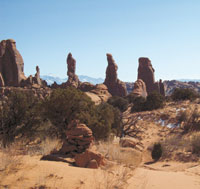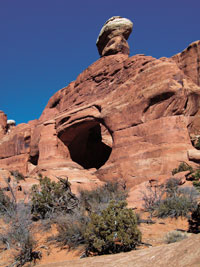Trail Happenings December 2009
TOWER ARCH AND THE MARCHING MEN
Doug Buttery
 Marching Men in Arches National Park
Marching Men in Arches National Park |
Looking for a moderately strenuous hike while walking beneath the Marching Men and experiencing one of the less visited areas in Arches National Park? In the northwest corner of the park, in an area known as Klondike Bluffs, the sixth largest arch in Arches National Park resides quietly awaiting exploration.
The Tower Arch trail is a 3.4 mile roundtrip hike beginning with a short, but steep climb. This climb is on a north facing slope. Caution is advised if snow or freezing rain has occurred recently, since this section of shelves, ledges and slick rock can be challenging. Upon reaching the ridge, on a clear day, you are rewarded with views of the La Sal, Abajo, and Henry Mountains. The trail serpentines into a pinnacle rimmed basin interspersed with Utah Juniper. Tufted titmice, pinion jays, the ubiquitous raven can be seen, and the occasional melodic descending song of the canyon wren can be heard.
About halfway between the trail head and Tower Arch is the rock formation known as the Marching Men. The Marching Men are a series of tall, thin towers that stand in a row atop a fin, much like soldiers at attention. After crossing a wash and ascending a short sandy section of trail, a look back provides a wonderful peek-a-view of the snow capped La Sal
Mountains through these thin towers of Marching Men. The trail continues leading you into the fins of the Klondike Bluff.
Tower Arch comes into view subtly showing its 92 foot span. As you approach, the awe inspiring immensity of Tower Arch comes as much from its impressive size as it does from its depth and solid presence. It is an arch befitting the entrance to an Olympian palace, solid, intimidating, and defiant in its reclusive, graceful span.
 Tower Arch in Arches National Park
Tower Arch in Arches National Park |
In his wanderings, Alex Ringhoffer found this arch in 1922. His name can be found inscribed beneath this arch. During the summer of 2009 this piece of history was selfishly defaced with a staining liquid. Historic inscriptions can be found in several locations throughout the park. The historic relics found in our National Parks are protected by Federal Law. Scratching graffiti, or defacing historic relics lessens the experience for future visitors. Take photos, make memories, and leave no trace.
As with most desert trails, the Tower Arch trail traverses slick rock, ledges, sand, and soil. Don’t get mesmerized by the toes of your boots, and practice scanning ahead as you pass a carefully placed cairn (stacked rocks) to locate the next cairn. Proficiency at this route finding technique will keep you from losing the trail, damaging the fragile soils, and in the worst case, becoming lost and having to be rescued. During these scanning opportunities, keep a sharp eye out for several other unnamed windows and arches along this trail.
During a recent hike to this arch, we approached the base of the arch and discovered a couple of foreign visitors beneath it. We quietly waited our turn until they began their return hike. We enjoyed lunch, basking on the flat, south facing ledges near the arch and admiring the framed view of the Monitor and Merrimack buttes off to the south.
Directions to the Trailhead:
From US 191 (5 miles north of Moab) turn into Arches National park and drive 16.2 miles on the paved Arches Entrance Road. Turn left onto the unsigned gravel road about 0.3 miles past the Sand Dune Arch Trail. Follow the graded dirt road through Salt Valley for approximately 7.2 miles, continuing straight past the first left-hand turn. Turn left at the second road, signed Klondike Bluffs, 1 mile. Follow this road to the small Klondike Bluffs trail head. A vault toilet and a wayside exhibit are available at this remote site.
Generally a passenger car is sufficient, however the 7.7 mile dirt road leading to the trailhead can and does become impassable during or just after storm events and it is wise to contact the Arches Visitor Center for up to date road information prior to departure. The front desk can be reached at 719-2200.
Author Douglas Buttery is the Chief of Facility Management at Arches/Canyonlands National Parks. |

